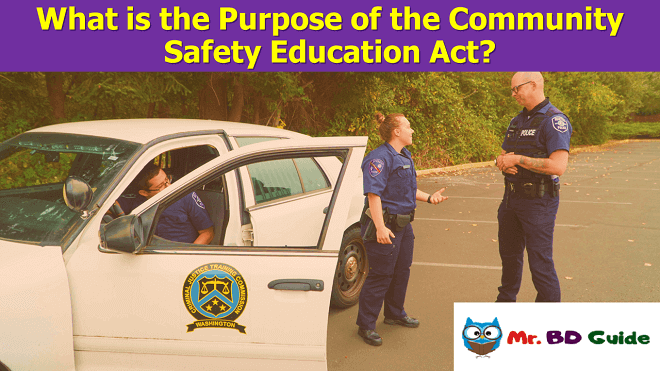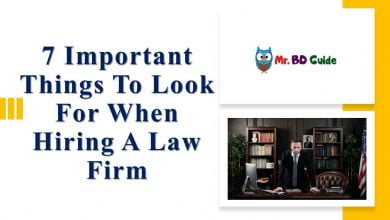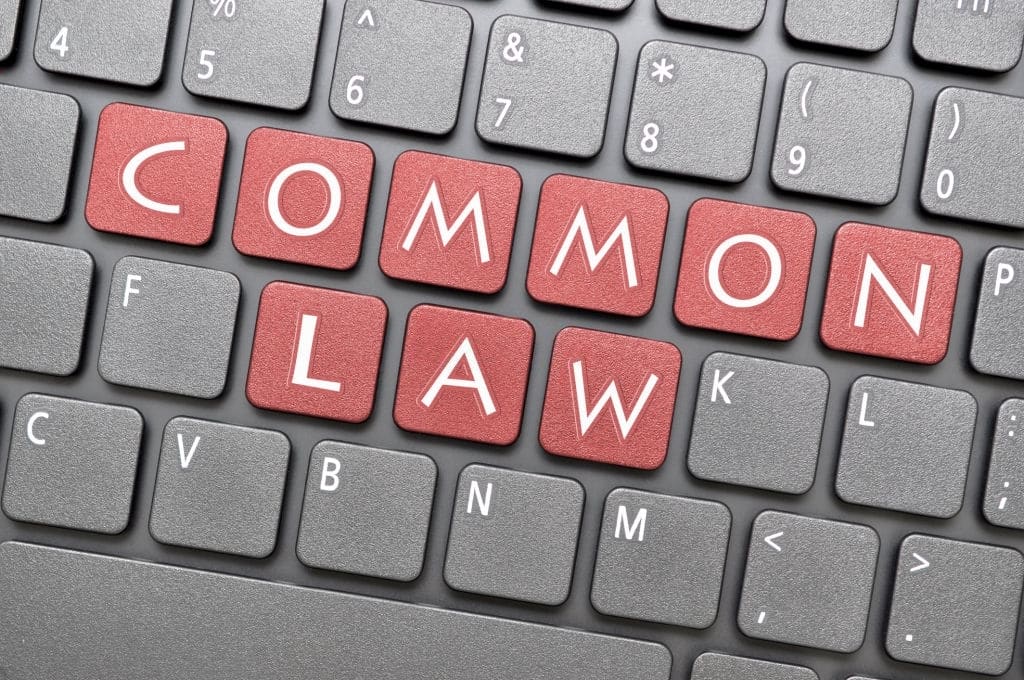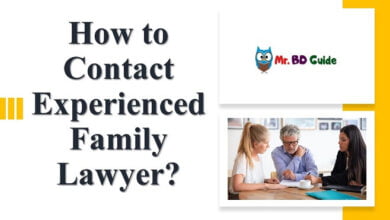What is the Purpose of the Community Safety Education Act?

People are asking over and over again that, What is the Purpose of the Community Safety Education Act? Why does it matter so much, or what changes does it bring to society? Well, there’s much more than you think it can get to the community in terms of safety. Let’s go through each of them throughout the whole article here.

The Community Safety Education Act necessitates that driver education and driving safety educational plan incorporate data about the appropriate methodology for resident and law authorization interaction during traffic stops.
The law necessitates that driver education and driving safety educational program incorporate data about appropriate techniques for resident and law requirement interaction during traffic stops. One of the new law’s objectives is to decrease strains and tensions that may emerge during interactions among officials and residents that could prompt undesired results.
Let’s Dig More into It
The objective of the act was to characterize the conduct desires for residents and law implementation during traffic interactions,” says state Sen. Royce West, a Dallas liberal who wrote the enactment, toward the start of the video. “We realize that in certain networks, there’s an issue concerning trust between law authorization and the community.”
Under the law, the State Leading body of Education and the Texas Commission on Law Requirement would cooperate to build up guidance on interacting with law implementation for understudies in grades 9-12 and a non-military personnel interaction preparing the program for harmony officials. Driver education and safety courses likewise would remember guidance for what to do during traffic stops.
What is the Purpose of the Community Safety Education Act?
This direction’s primary function is to ensure the two authorities’ and locals’ prosperity beforehand, during, and rapidly following traffic stops. Unite with a school resource official or a specialist of neighborhood law necessary to give direction.
Senate Bill 30 or the Community Safety Education Act will, in general, police and local joint efforts and requires the State Leading Group of Education. Through the Texas Education Office (TEA) to make instructional materials for auxiliary schools understudies on how they, as future drivers, should react when ended by law usage.
Purpose of Texas Community Safety Education Act
The purpose behind the Community Safety Education Act is to offer information to drivers, individuals by and large, and understudies. Besides planning for people from law necessity, each should have during a contact among authorities and drivers on the longings that each should have.
- Making Safe Interaction among residents and law authorization
- Data for drivers, general society, understudies, and furthermore preparing for individuals from law authorization
- Desires that each ought to have during contacts among officials and drivers.
- The objective is to diminish strains and tensions that may emerge during interactions among officials and residents during traffic stops and different experiences that could prompt undesired results.
The Community Safety Education Act requires the State Leading body of Education (SBOE) to receive rules to incorporate the guidance created under Texas Education Code (Sleuth) & #167;28.012 in at least one course the necessary educational plan for understudies in grades 9-12.
[i.e.] every understudy who enters grade 9 in the 2018-2019 school year. From there on, in any event, once before graduation from secondary school, not understudies in grades 10-12 in the 2018-2019 school year.Instruction of Community Safety Education Act
The Community Schools Act is enacted to give a technique to put together a community’s assets to guarantee understudy achievement while tending to the entire understudy’s necessities. To accomplice government, state, and nearby substances with private community-based associations to improve the coordination, conveyance, viability.
- The part of law authorization and the obligations and duties of harmony officials
- An individual’s privileges concerning interactions with harmony officials
- Appropriate conduct for regular citizens and harmony officials during interactions.
- Laws regarding addressing and confinement by harmony officials, including any law requiring an individual to introduce confirmation of personality to a harmony official, and the ramifications for an individual’s or official’s inability to follow those laws
- How and where to document a protest against or a commendation in the interest of a harmony official.
Now we know the purpose of the act, but have you really seen the act yourself? Well, I have, but for a regular citizen, the act does not seem to be comfortable while you read. So, to do it comfortably, the government has published a guideline for those who will teach. Here’s we are going to present it for you. However, it was published on the official website as a PDF file.
The state of Texas Community Safety Education Act Instructor’s Guide
Instruction for Students on the Proper Interaction with Law Enforcement During Traffic Stops, Authorized by Senate Bill 30, 85th Texas Legislature, 2017
Flashing Lights: Creating Safe Interactions between Citizens and Law Enforcement
Flashing Lights: Creating Safe Interactions Between Citizens and Law Enforcement is a product of the Texas Community Safety Education Act (Senate Bill 30), passed by the 85th Texas Legislature. The act aims to define the behavior and expectations of citizens and law enforcement during traffic interactions. Check out the video below. If you watch the entire video carefully, then you will know What is the Purpose of the Community Safety Education Act?
Tips for Educators Who Will Teach The Act
Thank you for providing this vital instruction to students on proper interaction with law enforcement. This instruction’s primary purpose is to ensure both officers’ and citizens’ safety before, during, and immediately following traffic stops. The focus of this instruction should be on ensuring everyone’s safety.
- Partner with a school resource officer or a representative of local law enforcement to provide instruction.
- Before sharing information, assess students’ knowledge toward traffic stops.
- Before sharing information and throughout instruction, assess students’ attitudes toward traffic stops.Assess whether attitudes have shifted following instruction.Make sure to address any misperceptions
- During the question and answer portion of the video, periodically pause after a question is asked and before the officer answers. Ask students what they think the answer will be.
- Students may ask about citizens videotaping traffic stops. It is a citizen’s right to videotape. Drivers and passengers should be aware that unknown items in a citizen’s hand may cause officers’ safety concerns.
- The key point for students to remember is that officer instructions are focused on ensuring all involved safety.
- Use the quiz at the end of this section to assess students’ knowledge and understanding of the information provided.
Section 1: The Role of Law Enforcement and the Duties and Responsibilities of Peace Officers
Complete this section with students before showing the videos.
Guiding Questions
- What do you expect will happen during a traffic stop?
- Has anyone experienced a traffic stop? Tell the class what happened during the traffic stop. How did you feel at the time?
It Is What You Should Expect From An Officer When You Experience A Traffic Stop
- Officers should treat motorists with dignity and respect.
- Officers are not required by state law to provide their names or badge numbers to a driver but may do so if required by agency policy.
- It is recommended that an officer explains to a driver that when a citation is issued, it is with the implied agreement that the driver will appear in court or make the arrangements necessary to satisfy the court appearance. The officer should also instruct drivers to read the citation’s information regarding the driver’s obligation to appear in court.
- When seeking to perform a consensual search, officers should elicit explicit consent for the examination, including, when practicable, a signed statement or video recorded affirmative consent to the investigation from the motorist.
Section 2: Rights Concerning Interactions With Peace Officers
Complete this section with students after showing the first portion of the video before the interaction between the officer and the driver (3:15 minute mark). Its a vital part if you want to know What is the Purpose of the Community Safety Education Act?
Guiding Questions for the Section
- What are some things you think you should do when interacting with a peace officer during a traffic stop?
- What are some of the things you think you shouldn’t do when stopped?
Now the section is divided into two parts: the drivers and the other for the passengers. Let’s check both of them out.
Notes For Drivers
- Law enforcement and drivers should respond with courtesy during traffic stops and other officers/citizen interactions.
- Although it is lawful for you to remain silent during a traffic stop, you are required by law to truthfully identify yourself when asked to do so by an officer. A driver or passenger can be arrested for giving false identifying information to an officer.
- Although you have the right to remain silent, it may be beneficial to verbally identify and address an officer’s information if you cannot present your license.
- An officer may conduct a nonconsensual search based on an officer’s observation that you have responded in a way to make the officer believe that you have engaged in a criminal act or are about to engage in a criminal act.
- If an officer suspects that a weapon is on your person, the officer may conduct a pat-down search of your clothing. A driver may not physically resist the investigation but has the right to notify the officer that they do not consent to any further inquiry. Consent to a search may later be used in court.
- If you are placed under arrest, it is an offense to refuse to identify yourself, not provide your address, or refuse to give your date of birth to an officer.
Notes for Passengers
- Law enforcement and passengers should respond with courtesy during traffic stops and other officers/citizen interactions.
- A passenger in a vehicle should receive instructions advising him or her that they can be asked questions by an officer while being detained. However, a passenger can ask an officer if he or she is being arrested or if he or she is free to leave. A passenger has the right to leave if he or she is not being detained.
- Although it is lawful for you to remain silent during a traffic stop, you are required by law to truthfully identify yourself when asked to do so by an officer. A driver or passenger can be arrested for giving false identifying information to an officer.
- Although you have the right to remain silent, it may be beneficial to verbally identify and address an officer’s information if you cannot present your license.
- An officer may conduct a nonconsensual search based on an officer’s observation that you have responded in a way to make the officer believe that you have engaged in a criminal act or are about to engage in a criminal act.
- If you are placed under arrest, it is an offense to refuse to identify yourself, not provide your address, or refuse to give your date of birth to an officer.
Section 3: Proper Behavior For Civilians And Peace Officers During Interactions
Complete this section with students after showing the remaining portion of the first stop in the video (4:38 minute mark).
Guiding Questions For The Section
- How do you feel when you are stopped?
- How do you think the officer feels? Why do you believe that?
- What should you do when you are pulled over?
- What should you NOT do when you are pulled over?
- How should passengers behave during a stop?
While Being Stopped By An Officer, You Should Do The Following
- Slow down immediately and pull over to the right side of the road as soon as possible.
- Park your vehicle on the right shoulder or to the right of the road as far and as safely possible. If safe parking is unavailable at the roadside, move slowly to a side street or parking lot away from high volume traffic.
- When visibility is limited, activate your vehicle hazard lights and/or interior dome lights.
- Drivers should be advised that an officer may approach their vehicle from the passenger side for safety reasons.
Once Your Vehicle Is Stopped, You Should Do The Following
- Place the vehicle in park, engage the emergency brake, and turn your engine off.
- Keep both of your hands visible on the steering wheel, and passengers should keep their hands in plain sight.
- Lower your window. It is required by state law.
- Before attempting to access your license or insurance documents, notify the officer of your items’ location and advise the officer that you are going to get the things.
- Follow the officer’s instructions. When the officer approaches your vehicle, specific movements such as reaching and searching for required documents could be interpreted as a threat to the officer’s safety or indicate possible criminal activity.
- Remain inside the vehicle unless you are instructed to exit by the officer. If required to exit the vehicle, check traffic, and do so safely.
- Notify the officer if there is a firearm inside your vehicle. You should store all required documents in a different location from the firearm.
When Your Vehicle Is Stopped, You Should NOT Do The Following
- Reach or search for your license or insurance documents before or while the officer approaches the vehicle
- Attempt to leave a traffic stop until the officer has indicated that the stop is complete. At that time, you should give the appropriate signal and re-enter traffic safely.
If you are not sure that the vehicle performing the traffic stop is a police car, you should drive slowly and carefully, below the speed limit, to a well-lighted and populated location. You may contact 9-1-1 and remain on the line until the officer’s identity is verified. You should know all these critical matters if you want to understand, What is the Purpose of the Community Safety Education Act?
NOTE: It is a violation of state law, and you can be arrested for not stopping when the vehicle performing the stop is a marked law enforcement or emergency response vehicle.
Section 4: Filing A Complaint Against Or A Compliment On Behalf Of A Peace Officer
Complete this section with students after showing the final portion of the video.
Note to instructor: Find the relevant information from local law enforcement information and provide that information to students in addition to showing the following samples.
- The time to make an argument or complain is not during the traffic stop. There are formal processes and procedures that you can and should follow to file a complaint.
- You can also file a formal compliment when you have a positive experience.
- You can complete an online search to find specific complaint and compliment instructions for your local law enforcement.
Here Are Samples Of Complaint and Compliment Websites
- Texas Department of Public Safety (DPS)
- Texas Commission on Law Enforcement (TCOLE)
- Dallas Police Department
- Austin Police Department
- Houston Police Department
Community Safety Education Act Post Quiz
Well, now you understand everything if you read the whole article carefully. As a citizen, you must understand the consequences of the law and the act so that you can remain safe. You must check how carefully you read it, and to make sure, here’s a quiz for you. Let’s check it out first. Remember before you start, all these questions are essential if you want to understand What is the Purpose of the Community Safety Education Act?
1. Why should you slow down below the speed limit and turn on hazard lights as you exit a highway to pull over?
Answer: For your safety, it indicates to the officer that you’ve seen their flashing lights and are pulling over or looking for a safe place to pull over.
2. Why should you place your hands on the steering wheel while the officer is approaching?
Answer: For the officer’s safety, it signals to the officer that you are not armed.
3. If asked questions by an officer, you may not remain silent during a traffic stop.
Answer: False
4. When should you retrieve your driver’s license and registration? Why?
Answer: After the officer has approached your vehicle, you should notify the officer of your items’ location and advise the officer that you are going to get the things.
Answer: Certain movements, such as reaching and searching for required documents before the officer approaches the vehicle, could be interpreted as a threat to the officer’s safety or indicate possible criminal activity.
5. If you are involved in a traffic stop as a passenger, you may leave if you are not detained.
Answer: True
6. An officer will always approach your vehicle from the driver’s side.
Answer: False
7. You can be arrested for not stopping when the vehicle performing a stop is a marked law enforcement vehicle.
Answer: True
8. What should you do once the officer has indicated that the stop is complete?
Answer: You should give the appropriate signal and re-enter traffic safely. Do not wait for the officer to re-enter traffic first.
Frequently Asked Questions: Community Safety Education Act
1. What is Senate Bill (SB) 30, Community Safety Education Act?
SB 30, also known as The Community Safety Education Act, was passed by the 85th Texas Legislature, Regular Session, 2017. The legislation added Section 28.012, regarding the instruction on interaction with law enforcement, to the Texas Education Code (TEC). The legislation requires the State Board of Education (SBOE) to adopt rules to include the instruction developed under TEC, §28.012, in one or more courses in the required curriculum for students in grades 9-12.
2. What new rule did the SBOE adopt to implement the Community Safety Education Act?
The SBOE adopted a new rule in Title 19 of the Texas Administrative Code (TAC), §74.39, Requirements for Instruction on Proper Interaction with Peace Officers, that became effective August 27, 2018.
This rule requires school districts and charter schools to provide instruction to students in grades 9-12 on proper interaction with peace officers during traffic stops and other in-person encounters.
3. What students are required to receive this instruction?
The new requirement applies to any student who enters grade 9 in the 2018-2019 school year and thereafter, not students in grades 10-12 in the 2018-2019 school year.
4. When and how often are students required to receive this instruction?
The instruction must be provided to each student who enters grade 9 in the 2018-2019 school year and thereafter at least once before graduation from high school.
5. Must the instruction be provided as part of a social studies course?
No, this instruction may be provided as a part of any course in grades 9-12.
6. What content information should be included as part of the instruction on proper interaction with peace officers?
The instructional requirements for proper interaction with peace officers are specified in TAC §74.39. Requirements for Instruction on Proper Interaction with Peace Officers.The instruction must include all of the following information:
1. The role of law enforcement and the duties and responsibilities of peace officers;
2. A person’s rights concerning interactions with peace officers;
3. Proper behavior for civilians and peace officers during interactions;
4. Laws regarding questioning and detention by peace officers, including any law requiring a person to present proof of identity to a peace officer, and the consequences for a person’s or officer’s failure to comply with those laws; and
5. How and where to file a complaint against or a compliment on behalf of a peace officer.
7. What instructional materials should school districts and open-enrollment charter schools use?
A school district or open-enrollment charter school must use materials developed through a memorandum of understanding among the Texas Commission on Law Enforcement, the State Board of Education, and the Texas Education Agency. Materials to be used when providing the instruction required by the Community Safety Education Act include a 16-minute video and an instructor’s guide. These materials are available on the Texas Gateway at https://www.texasgateway.org/resource/flashing-lights-senate-bill-30.
8. May school districts or open-enrollment charter schools change or alter the required instruction?
Yes, according to TAC §74.39 (d), school districts or open-enrollment charter schools may tailor instruction as appropriate for the district’s or school’s community. In tailoring the instruction, the district or school is required by TEC, §28.012 to solicit input from local law enforcement agencies, driver training schools, and the community. The tailored instruction must cover all the content specified in TAC §74.39 and provided in the video and instructor’s guide on the Texas Gateway.
9. Is it required that a peace officer or a teacher provide the instruction? If a teacher provides the instruction, must a peace officer be present?
There are no specific requirements stated in TAC §74.39 as to who may provide the required instruction on proper interaction with peace officers. However, the teacher of the course in which instruction is provided must have the appropriate credentials required for that course. The presence of a peace officer is not required.
10. What documentation is required to show that a student has completed the required instruction on proper interaction with peace officers?
TAC §74.5(k) requires school districts and open-enrollment charter schools to clearly indicate the completion of the instruction on the student’s academic achievement record (transcript). There is no other required documentation specified in TAC §74.39. To learn more about academic achievement records, please go to: http://tea.texas.gov/Academics/Academic_Achievement_Record.
11. Where Did We Collected These FAQs?
1. Here’s a online version of these FAQs: Click Here to See
2. Here’s a PDF version of these FAQs: PDF Download
References
- Flashing Lights Senate Bill 30
- Community Safety Education Act Instructor’s Guide
- Frequently Asked Questions
Final Words
We are at the end of our discussion on community safety education act. As you know, its a matter of governmental rules and regulation, everybody must obey all these rules. We have shared the most resourceful explanation on the purpose of the community safety education act with latest information. if you read the entire article then you will know What is the Purpose of the Community Safety Education Act?




